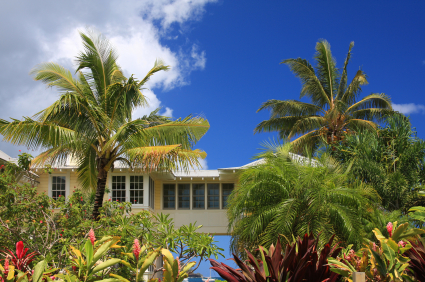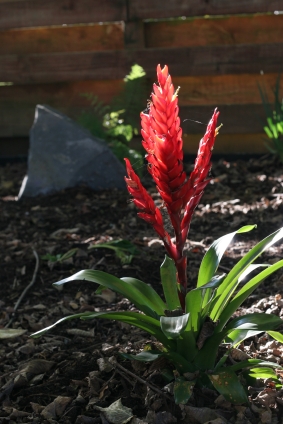The Best Bromeliads for Outdoor Landscapes
Author: Melanie Dearringer6 Comments
Care and Culture, Growing Outdoors
Most bromeliads are native to tropical areas and as a result are often grown as indoor plants. However, if you live in a zone that does not regularly drop below freezing bromeliads can make a beautiful and easy landscape plant.
Bromeliads are great landscape plants because they usually don’t require much water. Depending on the variety they enjoy the humidity and air circulation that being outdoors provides. They also produce pups or offsets very easily and they will quickly cover the ground in attractive clumps. Their foliage adds desirable color and texture to any outdoor landscape.
CHOOSING A BROMELIAD

-Bromeliads add an exotic look to landscapes.
Make sure you choose bromeliads that can handle occasional temperatures that drop into the twenties and thirties if you experience a frost in the winter. Bromeliads that are native to subtropical regions and higher elevations are usually the most adapted to surviving in cold temperatures.
PLACEMENT
It is often best to plant your outdoor bromeliads in the shelter of eaves or other trees. This will protect the bromeliads from scorching sun in the summer and cold conditions in the winter.
HOW TO WATER DURING COLDER SEASONS
There is some debate about whether or not the central tanks of bromeliads should be filled with water before a freeze. Some experts report that if it freezes it can kill the bromeliad, while others report that it helps the plant to survive. In general, it is best to cut back on water in the winter. This will help your plant go into a dormant state that is less likely to be damaged by cold weather. However, if you are expecting a frost, you may want to water the ground around the bromeliad and put water in the central tank. The water in the ground will help the ground temperature stay slightly higher than the air temperature. If the water in the central tank freezes, break up the ice and remove it as soon as possible.
There is always some risk when planting bromeliads outside where they may be exposed to freezing temperatures. However, with proper care, most will pull through with only a little damage. They often quickly recover.
GENERA AND SPECIES

-Red bracts add a pop of color
Puyas are generally a genus of bromeliad that handle cold temperatures well. They are native to higher elevations and can therefore tolerate some temperature swings. They often have a grass like appearance and produce tall flower spikes that can last throughout the summer and fall.
Puya dyckioides is a bright green bromeliad with slender leaves. It has smaller, more manageable thorns than many other Puya species. It producea a 3 foot tall bright pink flower stalk that matures to bright red. The flower stalk is long lasting, but it takes up to six years for a plant to reach maturity and produce the stalk. The offshoots of this plant can create a mat up to six feet wide.
It likes plenty of bright light, but should be shaded in the afternoon when the sunlight is most intense. This plant can also handle temperatures down to twenty degrees, but young plants should be protected from frost.
Neoregelias are beautiful foliage plants that love the sun. They can handle plenty of bright sunlight and high temperatures. The plants will stay smaller and more dense and brightly colored when they receive plenty of sunshine. If they begin to bleach out, they are being exposed to too much sunlight. When they turn dark green they are not getting enough sunlight.
Many Neoregelias can handle temperatures into the twenties. They may have some damage to the leaves and may loose some of their color, but they usually recover quickly when temperatures warm up.
Neoreglia ‘Fireball’ is a popular Neoregelia that has thick leathery leaves that are deep red. It is a low growing plant that only reaches four to six inches high. It can spread to make thick mats. It is hardy only down to twenty-five degrees. This plant should be protected from prolonged exposures to frost. It will do well in sub tropical zones that rarely experience freezing temperatures.
Neoregelia spectabilis is hardy in USDA zones 9b-11. It has thick, broad, green leaves that are tinted red on the tips. Because of this characteristic is often called the painted fingernail plant. It is a low growing, quickly spreading plant that is used for a ground cover. It can tolerate a wide range of sunlight from shady to bright light.
Dyckias are hardy plants that can withstand temperatures into the teens at times.
They are typically small terrestrial plants, but will often grow to fill the space in which they are planted. Many are very stiff with sharp spines. They often form tight attractive rosettes with very unique foliage. In addition to tolerating low temperatures they prefer full sunlight. They are a not easily scorched and their bright colors will flourish in direct light.
Dyckia ‘Cherry Coke’ is a popular cultivar of Dyckia. Its slender, spiny leaves are a dark maroon color similar to cherry cola. It is a larger Dyckia that can grow over two feet high and wide. It pups easily and produces tall flower spikes that rise above the foliage with bright orange-yellow flowers.
Dyckia fosteriana is another popular species of Dyckia. It is a smaller plant growing between six and twelve inches tall and wide. It has green to gray leaves with sharp white spines around the margins. It produces a tall woody flower spike that sets on red flowers in the early spring. This plant is very drought tolerant and an excellent choice for xeriscaping.
Hechtia are another excellent xeriscape genus of bromeliad. They are native primarily to Mexico, but extend up a bit into Southern Texas and northern Central America. They are very drought tolerant and require little care. They prefer cooler temperatures at night, but can survive hot summers when watered more generously. They are often similar to Dyckias in that they are small, terrestrial plants with sharp spines around the margins.
Hechtia glomerata is a species that grows primarily on rocks. It can range greatly in size depending on its environment. It has slender green leaves that can become maroon when it receives enough light. The leaves are edged by a very sharp spines.
TIPS TO REMEMBER
There are many more bromeliads that will make excellent landscape plants. Just keep a few things in mind as you choose them:
- What is their natural habitat? Hot, humid, dry, sunny, mountainous, etc. Knowing what they are naturally adapted to will help you place them in your landscape and care for them properly.
- If you are worried about freezing temperatures, you can always use containers. Pots can be easily moved to sheltered areas when frost strikes. Bromeliads grow well and will still look attractive in your landscape in containers.
- Most bromeliads multiply, do you have space for the pups? Will you repot or replant them?
- If you are unsure of a particular bromeliad’s needs, consult a professional grower before committing them to your landscape.
With a little planning, you can have a beautiful border or ground cover full of hardy, easy to care for bromeliads.
What is your favorite bromeliad species or cultivar to use in outdoor landscapes?
Sources
Cater, Karen. “How to Care for a Neoregelia ‘Fireball’” SFGate Home Guides. <http://homeguides.sfgate.com/care-neoregelia-fireball-32348.html>
“Dyckia x ‘Cherry Coke’” YuccaDo Nursery Inc. <http://www.yuccado.com/dyckia-x-cherry-coke.html>
Jenkins, Dale W. “Cold Sensitivity of Bromeliads” Sarasota Bromeliad Society <http://fcbs.org/articles/cold_sensitivity_of_bromeliads.htm>
Gilman, Edward F. “Neoregelia spectabilis” University of Florida Cooperative Extension. <http://hort.ifas.ufl.edu/database/documents/pdf/shrub_fact_sheets/neospea.pdf>
“Major Bromeliad Genera” Bromeliad Society/Houston. <http://bromeliadsocietyhouston.org/genera-intro/>
“Plant Files Dyckia” Dave’s Garden. <http://davesgarden.com/guides/pf/go/98602/#b>
“The Pink Puya” Strange Wonderful Things <http://www.strangewonderfulthings.com/103.htm>
“Stoloniferous Hechtia glomerata in Queretaro” Eagle Eye Adventures. <http://eagleeyetravel.blogspot.com/2013/05/stoloniferous-hechtia-glomerata-in.html>
6 Responses to “The Best Bromeliads for Outdoor Landscapes”
Leave a Reply

Resource Download
Hechtia Care Cheat Sheet
Learn how to care for your Hechtia bromeliad with this quick and easy informational guide.
Learn More
Ask an Expert
Questions about bromeliads?
Our experts love a challenge!
Photo of the Week
Submit your photo to be featured on the blog!
More Photo of the Week Winners
Submit Photo








This is an Amazing website!!!! (I don’t know why I can only type caps. sorry) I would have thought Billbergia would be mentioned here., But maybe this is a relatively new site and still growing. Great success to you!!! BTW I found it while looking for abromietella info.
Shmuel
Can I plant them under a really big norfork island pine tree?
Do i need to control watering my brows which are in a shade house during winter we do not get frosts
What types of bromeliads can I plant in my cabbage palm tree? Can all go without soil or do some need soil? Thank you
Most all types of bromeliads are ephifites. Which means that they grow on the branches of trees
I have billbergia and vereshia in the landscape under a large hickory tree in southern central coastal area of Florida. Near the lagoon. We had frost 2 nights ago and night time temps have been at or near freezing for three nights. I hope they will recover from the cold I did not cover the bed of bromeliads. Should I be concerned about cold damage.